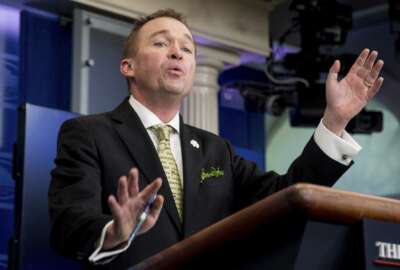More than 100 days stand between the third and fourth quarters of fiscal 2017, but industry partners say keeping up with the transition is going to be crucial for contractors.
Civilian spending in this quarter is slow and unpredictable due to the current continuing resolution that is funding government. Larry Allen, president of Allen Federal Business Partners, said it is almost futile for agencies and contractors to make plans until the fourth quarter — but they should still stay alert.
“Any time you get that uncertainty, it’s going to affect the acquisition process,” Allen said on the Federal Drive with Tom Temin. “But, the fourth quarter, particularly after this past week in Washington where we had cold and snow, may seem like it’s far away off … but it’s really where you want to keep your sights focused because that’s when a lot of confusion that is going to dominate the next month or so will be cleared up.”
Despite the Trump administration releasing it’s 53-page budget proposal last week and the current CR set to expire at the end of April, the budget for the final quarter of fiscal 2017 is still a mystery. Being better informed during the transition process will help contractors come out on top, especially since they aren’t directly in the middle of it, Allen said.
“My guess would be that the better informed contractor probably knows more than his or her federal customer about what’s going on with the budget or what could happen to spending simply because they are better positioned and maybe have a different view into these goings on than do their contracting officer colleagues inside of government,” he said.
President Donald Trump proposed in his “skinny” budget a raise in spending limits for both the Defense and Homeland Security departments, but significant cuts for civilian workers.
“[And this] has thrown what seemed to be a predictable path into a little bit of disarray in that we are now not sure that all the money that the administration is requesting would honor the budget agreements that have already been put in place,” Allen said. “We might end up in a situation where, in addition to having to raise the spending limits for the DoD, [we have to] readjust the budget framework.”
Another question raised by the uncertainty centers on the fate of the General Services Administration. Over two months into the Trump presidency and a nomination for leadership still has not been made and his proposal would place the GSA already at a 17 percent reduction.
GSA is the government’s largest centralized buying agency and essentially the landlord for civilian agencies, Allen said. Beginning the quarter with a significant drop in spending could affect the logistics of any agency and how the workers meet their mission.
“I think the biggest cuts would come in the people department [and] if you don’t have the right people [or] enough people to implement your plans like strategic sources, you’re not going to be able to make any forward movement on them and you’re going to have to re-calibrate what your priorities [are],” Allen said.
IT and personal services contractors will be in the best position because of the recent executive order signed by Trump ordering top-to-bottom reorganization of agencies and a boost in cybersecurity projects, he said.
Copyright
© 2024 Federal News Network. All rights reserved. This website is not intended for users located within the European Economic Area.
